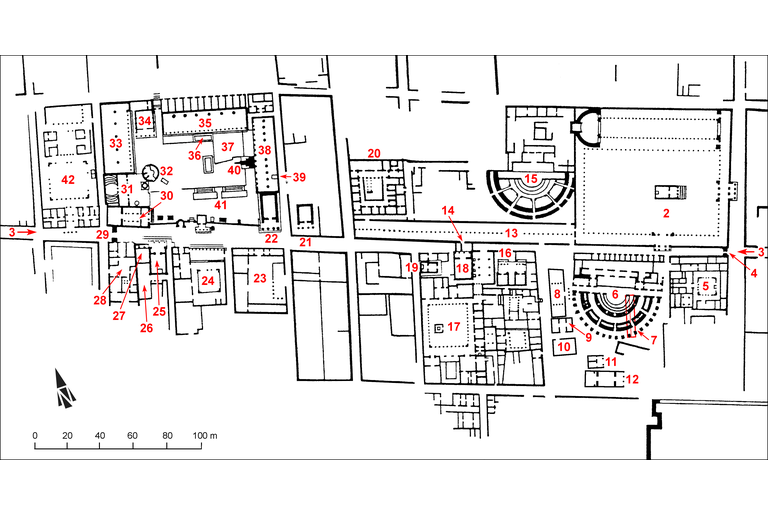Private honors
IGCyr131100
Trismegistos ID: 738858
Source Description
Repository
Cyrene Museum, 1835.
Support
Right part of a white marble block, re-cut at right and at the upper left angle, possibly also at back; broken off at left and below; a dowel hole on the upper right edge and a circular hole for attachment at back (0.24; 0.19;0.08).
Layout
Inscribed on the face in five lines, symmetrically displayed along the vertical axis with varying spaces between letters.
Letters
0.02 with small serifs; large circular letters, non-slanting sigma, phi with oval loop.
Place of Origin
Date
Probably first half of second century B.C. (lettering)
Findspot
Found in 1972 at Cyrene pleiades; HGL : re-used in the Byzantine tower built across the Street of Battos .
Last recorded Location
Seen by C. Dobias-Lalou in 1993 and again in 2001 in Shahat : Cyrene Museum .
Text constituted from
Transcription from stone (CDL).
Bibliography
Not previously published.
Text
Apparatus
French translation
(La statue de) Damatrios fils de K [---] , son frère, a été consacrée par Da [---] fils de [---] lanôr.
English translation
(The statue of) Damatrios son of K [---] , his brother, was dedicated by Da [---] son of [---] lanor.
Italian translation
(La statua di) Damatrios figlio di K [---] , suo fratello, fu dedicata da Da [---] figlio di [---] lanor.
Commentary
A sort of pi between lines 1 and 2 and a long vertical line cut on the right are visible on the photograph and squeeze. They are probably related to the re-use of the stone. A caption written with a pen reads 'CAR.ST.BYZ.FORT 1972'. Knowing of no Byzantine fort at Cyrene, we interpret it as the Byzantine tower that stood across Battos Street. However this was dismantled already in 1963 under supervision of Goodchild (see Luni, 2002 Luni, M., 2002, Lo Xystos-Portico delle Erme nel quartiere dell’Agorà di Cirene, in Archeologia Cirenaica. Atti del Convegno Internazionale di Studi, Urbino, 4-5 luglio 1988, Quaderni di Archeologia della Libya (QAL)16, 109-144 - see in bibliography , p. 124). We suppose that the date corresponds to the time when the inscription was discovered when building material was moved from that area as the Italian mission of Stucchi worked on the so-called Stoa of Hermes and Heracles.
For the first name at line 1, we restore the only name ending in ριος attested in Hellenistic Cyrenaica and fitting the gap. If ἀδελφός has it most common meaning, the dedicant and the honored man should share the same father's name, that is a name beginning with kappa (l. 1) and ending with λάνωρ (l. 3). None is known up to now, although *Καλάνωρ seems theoretically possible. On the other hand, two names are common at Cyrene, Φιλάνωρ and mostly Αίγλάνωρ, the latter being typically Cyrenaican. We should thus not exclude that both were half-brothers through a common mother, which is the etymological meaning of ἀδελφός. If so, there would be no problem with two different fathers' names.
Creative Commons Attributions-NonCommercial 4.0 International License.
All citation, reuse or distribution of this work must contain a link back to DOI: http://doi.org/10.6092/UNIBO/IGCYRGVCYR and the filename (IGCyr000000 or GVCyr000), as well as the year of consultation.
